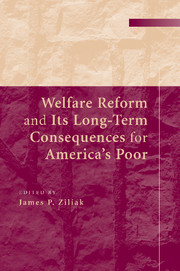Book contents
- Frontmatter
- Contents
- Contributors
- Preface
- Introduction
- 1 What We Know, What We Don't Know, and What We Need to Know about Welfare Reform
- 2 Welfare Reform and the Level and Composition of Income
- 3 How Have Expansions in the Earned Income Tax Credit Affected Family Expenditures?
- 4 How Families Are Doing Nine Years after Welfare Reform: 2005 Evidence from the Three-City Study
- 5 The Impact of Welfare Reform on Leaver Characteristics, Employment, and Recidivism
- 6 A Reexamination of the Impact of Welfare Reform on Health Insurance Among Less-Skilled Women
- 7 How Welfare Policies Affect Child and Adolescent School Performance: Investigating Pathways of Influence with Experimental Data
- 8 The Effects of Welfare and Child Support Policies on the Incidence of Marriage Following a Nonmarital Birth
- 9 Welfare Reform and Health among the Children of Immigrants
- 10 Mismatches and Unmet Need: Access to Social Services in Urban and Rural America
- Index
9 - Welfare Reform and Health among the Children of Immigrants
Published online by Cambridge University Press: 21 January 2010
- Frontmatter
- Contents
- Contributors
- Preface
- Introduction
- 1 What We Know, What We Don't Know, and What We Need to Know about Welfare Reform
- 2 Welfare Reform and the Level and Composition of Income
- 3 How Have Expansions in the Earned Income Tax Credit Affected Family Expenditures?
- 4 How Families Are Doing Nine Years after Welfare Reform: 2005 Evidence from the Three-City Study
- 5 The Impact of Welfare Reform on Leaver Characteristics, Employment, and Recidivism
- 6 A Reexamination of the Impact of Welfare Reform on Health Insurance Among Less-Skilled Women
- 7 How Welfare Policies Affect Child and Adolescent School Performance: Investigating Pathways of Influence with Experimental Data
- 8 The Effects of Welfare and Child Support Policies on the Incidence of Marriage Following a Nonmarital Birth
- 9 Welfare Reform and Health among the Children of Immigrants
- 10 Mismatches and Unmet Need: Access to Social Services in Urban and Rural America
- Index
Summary
Introduction
The 1996 federal welfare reform law introduced, among other things, broad restrictions on immigrants' eligibility for many health and social service programs, including cash welfare assistance (Temporary Assistance for Needy Families [TANF]), food stamps, and subsidized health insurance. Caseloads for welfare and other benefit programs have fallen dramatically in the wake of welfare reform (see the Introduction to this volume), but the declines have been steeper for immigrants than for native-born citizens (Fix and Passel 1999) even when immigrant families remain eligible for assistance. Indeed, most (80 percent) children in immigrant families, having been born here, are U.S. citizens, and are therefore eligible for government assistance on the same basis as all other U.S. citizens (Hernandez 2004). This phenomenon, which has been called the “chilling effect,” is thought to reflect immigrants' confusion about their eligibility for assistance or their fear that benefit use will adversely affect their chances for citizenship or even their opportunity to reenter or stay in this county (Capps 2001; Fix and Passel 1999; Maloy et al. 2000). For example, parents who are not citizens may not be aware of their U.S.-born children's eligibility for important benefits or may face other administrative barriers to accessing programs after leaving welfare. This is a particular problem among low-income parents with low education, as this population has a high proportion of noncitizen parents (Hernandez 2004).
- Type
- Chapter
- Information
- Welfare Reform and its Long-Term Consequences for America's Poor , pp. 308 - 336Publisher: Cambridge University PressPrint publication year: 2009
- 8
- Cited by



